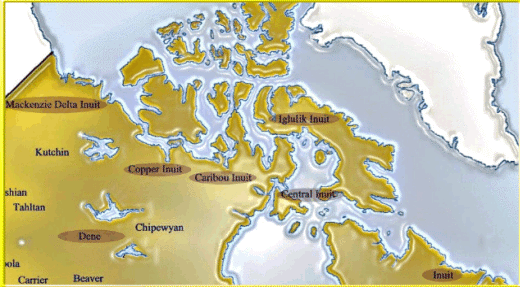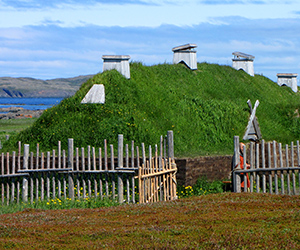CANADA HISTORY
Inuit

The arctic tundra and the scrub of the Northern forests were the home of this unique and very tough people. In the land of the polar bear, the seal, the arctic fox and of course snow and darkness, these people found a way to live and thrive. They were probably the last of the native groups to immigrate to North America starting about 4,000 years ago and continuing to just before the arrival of the Europeans. They lived along more then 12,000 miles of coastline which extended from Siberia across to Alaska and throughout the Canadian arctic to Greenland.
Their population around 1600 was estimated to be about 60,000. The name Eskimo is derived from the Abnaki people and means 'the eaters of raw flesh’ which is what they may have been reduced to do without extensive sources of fuel for fires and cooking.
The Inuit are a group of indigenous peoples who have historically lived in the Arctic regions of Alaska, Canada, and Greenland. Prior to European contact, the Inuit had a rich and complex culture that was deeply rooted in their environment and their way of life.
The Inuit were nomadic hunters and fishermen, and their subsistence was based on hunting sea mammals such as whales, seals, and walruses, as well as caribou and fish. They lived in small, tight-knit communities, and their social organization was based on extended families.
Inuit culture was also characterized by a strong spiritual belief system, which revolved around a pantheon of spirits and forces of nature. The Inuit believed in a wide range of spirits, including the spirit of the sea, the spirit of the land, and the spirits of the animals they hunted.
Inuit art and storytelling were also central to their culture. They created a rich tradition of carving, including sculptures made of ivory, stone, and bone, as well as making clothing and tools from animal hides and furs. Inuit storytelling was a way to pass down cultural traditions, beliefs, and history from one generation to the next.
Overall, the Inuit had a deep connection to their environment and a strong sense of community, which sustained them for thousands of years prior to European contact.
The Inuit had a rich spiritual belief system that was closely tied to their environment and way of life. They believed in a pantheon of spirits and forces of nature, and their spirituality was centered around a deep reverence for the land and sea, as well as for the animals they hunted.
The Inuit believed in a wide range of spirits, including the spirit of the sea, the spirit of the land, and the spirits of the animals they hunted. They also believed in an afterlife, where the spirits of the dead could continue to interact with the living.
Inuit spiritual beliefs also included the concept of shamans, who were believed to have the power to communicate with the spirits and to cure illnesses through spiritual means. Shamans were respected members of the community and were often called upon to perform rituals to ensure the success of a hunt or to bring good fortune to the community.
Inuit spiritual beliefs were expressed in many different ways, including through storytelling, dance, music, and art. They often created sculptures and carvings that depicted spirits and other spiritual beings, and these works of art served as visual representations of their beliefs and as a way to honor and connect with the spiritual world.
Overall, the Inuit spiritual beliefs were an integral part of their culture and way of life, and provided them with a strong sense of connection to the world around them and to their community.
The Inuit were nomadic hunters and fishermen, and their subsistence was based on hunting sea mammals such as whales, seals, and walruses, as well as caribou and fish. They lived in small, tight-knit communities and relied on each other for survival in a challenging and often harsh environment.
For housing, the Inuit built igloos and tents made of animal hides and furs, which were designed to provide warmth and protection from the elements. The construction of these structures was a highly skilled art, and they were built to be strong, durable, and well-insulated.
The Inuit used a variety of materials for their clothing and tools, including animal hides and furs, ivory, stone, and bone. They were skilled hunters and craftsmen, and their clothing and tools were designed to be functional and to last. They made warm, waterproof clothing from animal hides, and used ivory for carving and for the manufacture of weapons and tools.
In addition to hunting and fishing, the Inuit also gathered wild foods such as berries and roots. They were resourceful and made use of every part of the animals they hunted, using the meat for food, the hides for clothing and shelter, and the bones for weapons and tools.
Overall, the Inuit relied on their environment and their way of life for their subsistence, and they were able to adapt and thrive in a challenging and often harsh environment by using their skills and resources to the fullest.
The Inuit relied primarily on sleds pulled by dogs for transportation across the snow and ice. The sleds were made of wood and bone and were designed to be lightweight and easy to maneuver. The Inuit used dogs as draft animals because they were strong, hardy, and well-suited to the harsh Arctic environment.
In addition to sleds, the Inuit also used kayaks and umiaks (large, open boats) for travel on the water. These vessels were made of animal hides stretched over a frame of wood or bones, and were designed to be light, fast, and maneuverable.
For longer journeys, the Inuit also used dog sleds and kayaks in combination. They would travel by sled over the snow and ice, and then switch to kayaks when they reached open water. This allowed them to cover greater distances and to access a wider range of resources.
Overall, the Inuit had a variety of transportation methods that were well-suited to their environment and their way of life. They were able to travel efficiently and effectively across the snow and ice, as well as on the water, which was essential for their subsistence and for maintaining their nomadic way of life.
The two main forms of transportation they used were kayaks made from sealskin wrapped tightly around a frame, and, small sleds which were pulled across the snow by a teams of dogs.
They used two main methods for shelter depending upon their location and the seasons. Some would use sod to build small walls around a dug out area with a small pit in the middle for fire. Others would cut snow blocks from the snowfall and build a domed shelter know as an igloo.
Due to the severe climate in which they lived; their communities were unable to support large numbers of people. As a result, their social groups centered primarily on family or multi-family groupings. Consequently, there was very little historical record passed on to current generations or to historians.
The political structure of the Inuit was based on small, tight-knit communities, and was characterized by a decentralized and non-hierarchical system of governance. The Inuit did not have a formal political structure, such as a centralized government or a system of chiefs, but rather relied on consensus and cooperation to make decisions and resolve conflicts.
The Inuit lived in small communities of extended families, and decisions were made through discussion and negotiation among the members of the community. Leaders emerged based on their skills, knowledge, and experience, and they were recognized and respected for their ability to make decisions and resolve conflicts.
Inuit communities were highly interdependent, and the success of one community was seen as important for the success of all. They cooperated on a regular basis for activities such as hunting, fishing, and migration, and disputes were often resolved through mediation and compromise.
Overall, the political structure of the Inuit was based on a system of consensus and cooperation, with leaders emerging based on their skills and experience. This decentralized and non-hierarchical system of governance allowed the Inuit to effectively govern themselves and to maintain their small, tight-knit communities in a challenging and often harsh environment.
The first recorded contact between the Inuit and Europeans took place in the 16th century, when European explorers began to venture into the Arctic in search of a Northeast Passage to Asia. These early encounters were generally limited, as the harsh Arctic environment and the difficulty of travel made it challenging for the explorers to establish a lasting presence in the region.
It wasn't until the 19th and early 20th centuries that sustained contact between the Inuit and Europeans became more common, as whaling and trading activities brought more outsiders into the Arctic. During this time, the Inuit encountered a wide range of Europeans, including whalers, traders, and missionaries, and these encounters often had a profound impact on their way of life.
In some cases, the encounters with Europeans led to positive changes for the Inuit, such as the introduction of new technologies and goods. However, in other cases, the encounters were more disruptive, and the Inuit were forced to adapt to new ways of life and to deal with the challenges posed by outside influences.
Overall, the first contact between the Inuit and Europeans marked the beginning of a long and complex relationship that would have a lasting impact on the Inuit and their way of life. While there were many challenges and difficulties along the way, the Inuit were able to adapt and maintain their culture and traditions in the face of changing circumstances.
Here are some significant events and dates in the history of the Inuit:
1576: Martin Frobisher, an English explorer, encounters the Inuit while searching for the Northwest Passage. This marks the first recorded contact between the Inuit and Europeans.
1721: The Inuit encounter the Danish explorer Vitus Bering, who is searching for a Northeast Passage. This encounter leads to increased contact between the Inuit and Europeans in the following years.
Late 19th and early 20th centuries: Whaling and trading activities bring an increasing number of Europeans into the Arctic, leading to more sustained contact between the Inuit and outsiders.
1910: The Canadian government establishes the Royal Canadian Mounted Police (RCMP) to enforce laws and maintain order in the Arctic. This leads to increased control and regulation of Inuit life by the Canadian government.
1940s: The Canadian government begins a program of forced relocations of Inuit communities, moving them from their traditional homelands to more centralized locations. This policy has a profound impact on Inuit culture and way of life.
1970s: The Inuit begin to organize and advocate for their rights, leading to the creation of organizations such as the Inuit Tapirisat of Canada (ITC) and the Inuit Circumpolar Council (ICC).
1999: The Inuit gain greater control over their own affairs with the creation of the territory of Nunavut in Canada. This marks a significant step towards greater self-governance and cultural recognition for the Inuit.
Overall, these events represent important moments in the history of the Inuit, from the first encounters with Europeans to the efforts to maintain and preserve their culture and way of life in the face of changing circumstances.

Cite Article : www.canadahistory.com/sections/documents




